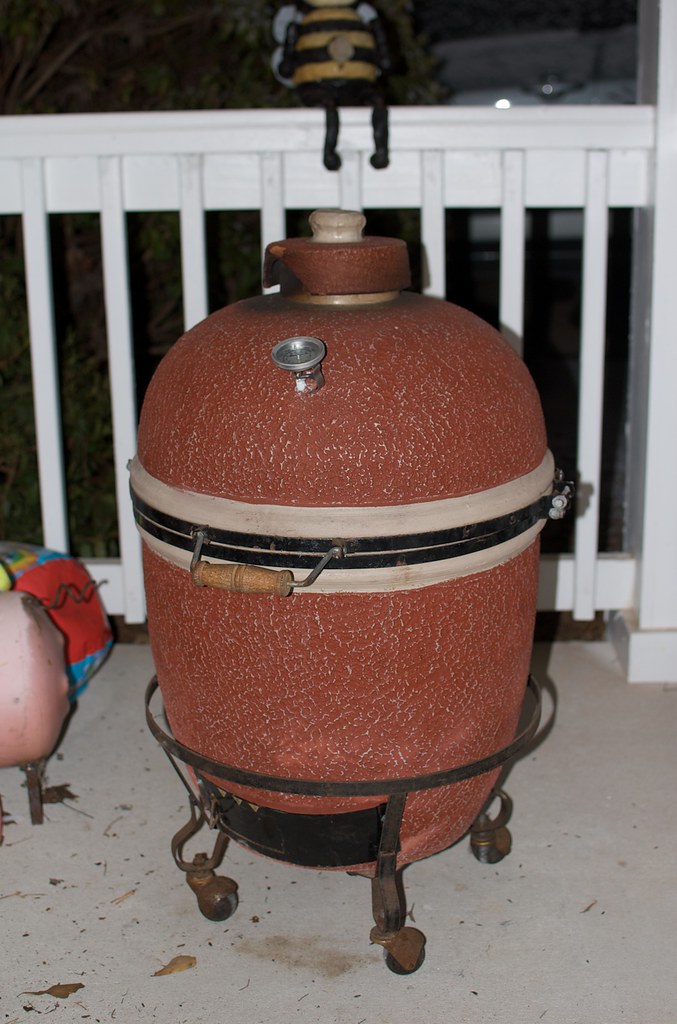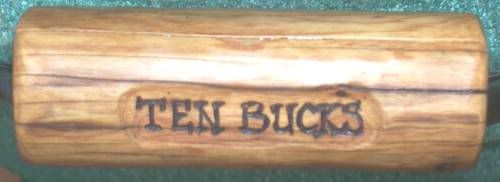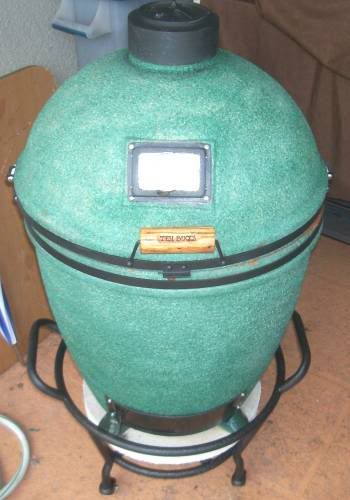Welcome to the EGGhead Forum - a great place to visit and packed with tips and EGGspert advice! You can also join the conversation and get more information and amazing kamado recipes by following Big Green Egg to Experience our World of Flavor™ at:
Want to see how the EGG is made? Click to Watch
Facebook | Twitter | Instagram | Pinterest | Youtube | Vimeo
Share your photos by tagging us and using the hashtag #BigGreenEgg.
Share your photos by tagging us and using the hashtag #BigGreenEgg.
Want to see how the EGG is made? Click to Watch
How to tell if it\'s ceramic or clay?
Options
I recently inherited a Kamado cooker from my uncle who lives in South Florida. When he and I were discussing this cooker that he no longer used, he kept referring to it as a "Big Green Egg". He apparently purchased it from BGE when he lived in Atlanta over 20 years ago.
I went and picked it up last month and was surprised to see that it didn't look like the BGE's I knew (I live in Tucker and have been pining for a BGE for years now). My uncle insisted it's a BGE despite the fact that it's not even green.
I've done some online research and have discovered that BGE did import and sell some Kamado's in the late 70's through early 90's that weren't like their current high-temp ceramic BGE's they sell today. From what I've read, most of these were made of clay and can't withstand the higher temps that modern ceramics can.
Here's my question though, how do I know if it's made of ceramic or clay? I've seen photos of other Kamados that look almost identical to mine, but they all have a distinctive orange clay color where they weren't glazed. Mine has a reddish glaze, but the unglazed parts are more of a pale gray than an orangish clay color. Could it be that mine is actually made of ceramic and not clay?
Here's some photos that might help anyone willing to share some insight. Thanks in advance!


I went and picked it up last month and was surprised to see that it didn't look like the BGE's I knew (I live in Tucker and have been pining for a BGE for years now). My uncle insisted it's a BGE despite the fact that it's not even green.
I've done some online research and have discovered that BGE did import and sell some Kamado's in the late 70's through early 90's that weren't like their current high-temp ceramic BGE's they sell today. From what I've read, most of these were made of clay and can't withstand the higher temps that modern ceramics can.
Here's my question though, how do I know if it's made of ceramic or clay? I've seen photos of other Kamados that look almost identical to mine, but they all have a distinctive orange clay color where they weren't glazed. Mine has a reddish glaze, but the unglazed parts are more of a pale gray than an orangish clay color. Could it be that mine is actually made of ceramic and not clay?
Here's some photos that might help anyone willing to share some insight. Thanks in advance!


Comments
-
The firebox and firering (the two separate pieces inside) look like they are from a modern bge.
-
Just a thought, but I'd suggest shooting the mothership an e-mail and photo.
They would know...
Great score though! Regardless of who made it, I'm betting shes got a "few" more cooks left in her!
-
Looks like one I picked up in SE Asia in '68. It was clay. Keep the temp under 350F and you should be OK.
-
Chambuzz, Now you will always remember your Uncle. What ever you cook in your cooker it will be because of your Uncle. So, I'm sure your Uncle is proud for you to have this cooker clay or ceramic their are more memories to be made. I hope you enjoy cooking on it.
 Tim
Tim -
does anyone have any definitive info why 350? i'm asking just so we can all understand it a bit more.
my understanding was that the new ceramics are better suited to resist freeze thaw and thermal shock due to extreme temps (especially the innards). the earthenware ones probably suffer more from freeze thaw issues. where water gets in and expands due to freezing. ...or expands due to high heat.
so if it is dry, there shouldn't be a major issue. certainly not one that keeps you down at 350.
the old egg manuals mention grilling in their literature too. no one was cooking steaks at 350 were they?
has an official "voice" said to stay under 350?
i'm just thinking it's more a case of staying under 650-700, and keeping it covered when not in use. that's paint, not glaze, so it will absorb water fairly easily. might go so far as maybe not using it in the winter, keeping it in the shed or garage perhaps, and dry.
i'm just absolutely sure that 350 is not the temp these things were originally supposed to operate at
sounds overly specific and yet arbitrary at the same time. -
I'm no eggspert but am under the impression that those with that design are all clay. That doesnt mean it is not a good egg. In fact, that is about the nicest, well maintained eggs of that age I have seen, and there has been alot.
Stripsteak makes what appears to be a good point, but I dont have the knowledge to agree or disagree. BUT if I were in your situation, I would use it as a lo/slo cooker and find a good used Small BGE(ceramic) for really hot cooks. -
stripsteak wrote:does anyone have any definitive info why 350? i'm asking just so we can all understand it a bit more.
...
the old egg manuals mention grilling in their literature too. no one was cooking steaks at 350 were they?
The Naked Whiz website has some copies of manuals that were included with Kamados sold in the late 70's. I looked at them yesterday and they state you shouldn't bring the temperature past 600 F. They even include a chart showing the various temperate ranges you can achieve if you alter the position of the draft door and top damper. With both wide open, it should be about 600 F, which is the draft door and damper position listed for the "Chef's Flank Steak" recipe included in the exact same manual.
I think 350 sounds too low, but I also don't think I'll be baking any pizzas on this thing any time soon.
In regards to the poster who suggested I contact the mothership, I actually did...well sort of. My father was down at my uncle's house before I got there and went ahead and called BGE HQ to inquire about this particular Kamado. The person my dad spoke to said they did indeed sell some of these and that they were all clay. I imagine that's probably what I have, but I was secretly hoping it was made of ceramic so I could use it more like an Egg. The non-clay looking color of certain parts made me think there was a chance it was actually ceramic.
I'll probably tinker with this thing for a while until I can convince my better half that we need to get a BGE to enjoy all that it has to offer.
-
I was told 350-375F years ago. Maybe mis-information. However I have a large and small BGE so they can handle the higher temps. Recently refurbished an Imperial Kamado about 20+ years old and plan on doing on it the lo-slo- type, butts, brisket, ribs etc.


-
some here dont go much higher in temp than that, what you will want to do with searing is get the grate as close to the coals as possible, almost touching, it will sear nicely there.fukahwee maineyou can lead a fish to water but you can not make him drink it
-
zackly. i thought 600 was fine. just don't leave it in the rain, then cook on it during a cold snap
600 is more than enough to sear steaks, you can drop the grid closer to the lump too, or fill it up. either ay, the lump is at 1100-1200 or more, and that's what you are really cooking with.
you could go dome open, too. that will keep the dome relatively cool compared to if it were shut and the egg were at 600 -
sounds awful low, frankly. the clay was fired at kiln temps...
maybe woodoggies will chime in, he's a literal expert in this regard -
It's a 70's vintage cooker distributed by the Pachinko Palace. It came in green and terra cotta and yes, it is a clay cooker. I have owned 2 of them since then (my Dad bought one for him and one for me, and I ended up inheriting his when his cooking days were over) and have several hundred cooks on both with no cracking, breaking, etc. Consider yourself a lucky man and enjoy it!
-
How hot are some of your hottest cooks and for how long?
-
I know for a fact that my steaks are started at or a little above 600 and I have done a bunch of them. The dome becomes too hot to leave my hand on for more than half a second. I think the secret to high temps is to bring the temp up slowly. I always start my charcoal in the firebox rather than dump a blazing chimney of red hots in all at once. I can't swear that will keep yours from cracking but, knock on wood, it has done the trick for me.

-
Thanks for the endorsement, JS, but having never seen one in person or knowing what materials they're made of or at what temp they were kiln-fired, gives me too little to give an opinion on the kind of temps those older cookers can handle.
If I had one, I would probably err on the safe side and resist getting it too hot. Low-fired ceramics won't handle expansion and contraction extremes nearly as well as modern high-fired ceramics like the egg. With the repeated stress of high temp cooking, the body could fatigue over time and lose integrity.
There are other variables, too. Any low-fired ceramic is like a sponge. Even if the cooker is kept covered it will still absorb humidity from air.
Heating up too quickly can turn the moisture to steam resulting in a crack or downright failure. Slowly building up temp would be the safest bet by slowly driving off any moisture that may be in the ceramic body.....
Anyways, if it were mine, I'd enjoy it for the vintage cooker that it is and play it safe by using only for lower temp cooking.... but I already have 3 eggs and can afford to play it safe. :~)
john -
oh what the hell do you know about ceramics?

cheers, mang! -
Thanks for all the insight guys! I'll probably keep her below 500 for the time being. She still needs a bit of work before I get her up and running though; a new gasket and a new thermometer at the least, and possibly a new firebox if I can't repair it with JB Weld and furnace cement.
I'll be sure to report back after I've had a few cooks on it. -
keep in mind that regular use will keep them dry, too.
my eggs act totally differently when they are water-logged (or 'damp-logged' i guess)
Categories
- All Categories
- 182.7K EggHead Forum
- 15.7K Forum List
- 459 EGGtoberfest
- 1.9K Forum Feedback
- 10.3K Off Topic
- 2.2K EGG Table Forum
- 1 Rules & Disclaimer
- 9K Cookbook
- 12 Valentines Day
- 91 Holiday Recipes
- 223 Appetizers
- 516 Baking
- 2.4K Beef
- 88 Desserts
- 163 Lamb
- 2.4K Pork
- 1.5K Poultry
- 30 Salads and Dressings
- 320 Sauces, Rubs, Marinades
- 543 Seafood
- 175 Sides
- 121 Soups, Stews, Chilis
- 35 Vegetarian
- 100 Vegetables
- 313 Health
- 293 Weight Loss Forum
